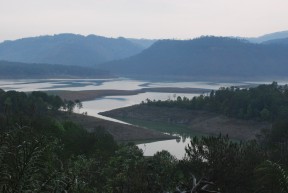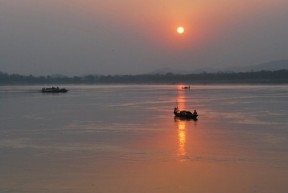Eventually, all things merge into one, and a river runs through it.
Norman Maclean
A friend said to me on my return from Assam in India’s North East, “There is a saying up there that goes ‘If you cross the Brahmaputra one time you are destined to return.’” In any case my mind wanders back to that peerless state at odd moments of the day and night, in my thoughts already I return there again and again.
There are a lot of legends and prophecies floating with the current of the mighty Brahmaputra River as it tracks it’s course from Tibet to Bangladesh, roaring down through narrow chasms and gobbling up land in its hunger to reach the sea. A river as wide as an ocean, blood red with stories of sacrifice and patricide, unusually for a river it is male in its aspect and unusually for India, it is not a holy river but often referred to as the Old Man River.
Apart from one day a year when the qualities of the water become divine enough to wash away the sins of a devotee, Brahmaputra spends his life washing away the efforts of man whether sinful or not. There still remains a divine union between the Brahmaputra and Mother Nature, the fruits of their union visible in the verdant jungles and fields so green that they could only have been painted by the co ordinated efforts of man in harmony with nature. Brahmaputra is not a river that will be easily tamed, it is a river that demands respect and submission.
Rare indeed to find a reference to this river without the word ‘mighty’ attached to it. A river of sorrow and munificence, the river is the blending and balance of our human lives measured against the flow of time. Every year hundreds of people are taken by the swift flow of flood as the river swells with monsoon rain and thousands more are nourished by the rich silt deposits left in its wake. Who can judge a river, one may as well argue about the way blood courses in veins through the human body. We have to trust nature to ensure the balance since nature has ways and means and rules that no human can challenge.
Such is the journey of the river that explorers for years were unable to locate the precise point of birth or to plot its course with any accuracy. In Tibet where the river leaps to freedom from the great glacier mass of the northern most chain of the Himalaya, the river is known as Tsangpo, meaning ‘purifier’. Sweeping and leaping through chasms, plunging through narrow valleys and collecting various tributaries along the way, the river twists and turns and executes hair pin bends before it spills into the North Eastern States of India. Here the river collects the Dhanasri River and becomes known as the Brahma putra, son of Brahma. Here the river rolls majestically through the valley, spreading arms and channels and oscillating from side to side leaving islands in its wake and swallowing up others according to its mood. Here lies what was once the biggest riverine island in the world, Majuli. What the river gives it will also take away and in recent years the river island has been reduced in status to the largest riverine island in India since the old man river has eaten away the southern end.
Rolling into the alluvial plains of Bengal, the Brahmaputra rushes to meet the River Goddess Ganga. United they dissolve into each other like lovers and spread fingers into the Bay of Bengal feeding and destroying the fragile river islands that exist at the end of the world in the area known as the Sunderbans.
If a river is the highway of life, cultures and commerce then the Brahmaputra is beyond par in this respect. With the effortlessness of a patriarch, a unique family of man gathers at his side, worships at his feet and accepts his rule with resignation tinged with respect.








Hi Dianne
i’ve read in today’s toi that china is planning to divert route of brahmaputra to serve its drought hit areas. I’m not sure as i have not read full news and went through headlines only.
Hi Rajesh yes according to my research the Chinese have lots of plans for the rivers that pass through both India and Nepal. Ownership of rivers and water is a huge political issue that I don’t think people are quite aware of in our rush for oil. After all you can run a car on water but you can’t drink oil!
This is one of the best article I have read on the mighty Brahmaputra. You have been able to capture the true essence of the river and I can feel your love and admiration. I live in Dibrugarh besides the Brahmaputra and ever since I was alive, I have given a part of my heart to the river. I love it too much, I respect it and I fear its might.
I would really appreciate if you could write this article in our blog as a guest author. It would be an pleasure to have your work.
Hello Vaivhav
thanks for your comments on the article. I am happy to help promote Assam. May I suggest that you link the article back to the Unboxed Writers site?
Hi Dianne,
I would certainly link the article back to this site. Please do see your article in our blog for we will be putting some more pictures of Brahmaputra.
Thank you very much !
Most welcome Vaivhav!